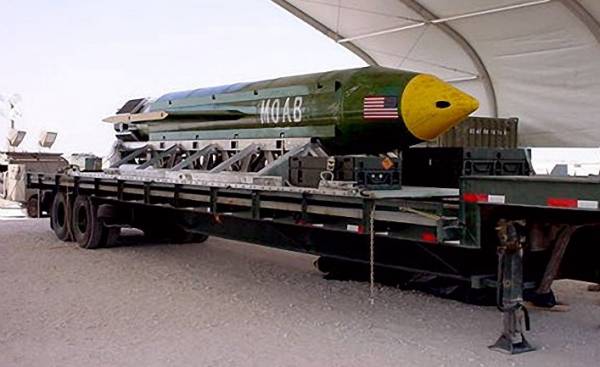
That’s the name that needs to remember all the ruthless terrorists of ISIS (a terrorist organization banned in Russia — approx. ed.) Barnes Wallis (Barnes Wallis).
This British scientist contributed to the fact that on 13 April 2017, the US air force dumped heavy duty high-explosive aerial bomb GBU-43, also known as the “mother of all bombs” in a tunnel complex in Afghanistan.
However, this heavy-duty high-explosive bomb — only the prodigal son of the weapons that were developed during the Second world war. Ancestors heavy-duty high-explosive bombs were British earthquake bomb, including bomb Tall Boy (“Big”), weighing 5.5 tons and the biggest bomb the Grand Slam (“the Big crunch”), weighing 10 tons.
Earthquake bomb was the invention of Barnes Wallace, the legendary British engineer and maker of bombs, famous for his inventions such as the Bouncing bomb used to destroy dams in the Ruhr area of Germany. But Wallace was faced with another challenge — a challenge that still haunts developers bombs.
Some objects can be quite easy to destroy with high-explosive bombs, which explode once touching the ground, or even in the air. These bombs can destroy tanks, artillery and men, regardless of how those smart and modern. As for the cities, that bombs of various sizes, weighing from 250 pounds to 2 tons — along with an incendiary weapon was enough to bulldoze or burn almost any German or Japanese city.
However, when the Nazis built concrete and underground facilities and tunnels, the allies had problems. German submarines based in France, used concrete shelters with concrete ceilings with a thickness of 7.5 meters. In numerous raids by British and American bombers flows of conventional bombs rained down on the cover of German submarines. However, the effect of their explosions can be compared with the impact of ping-pong on the armor of a tank. Moreover, the Nazis realized the benefits tactics the mole and began to move their factories into the underground bunkers. And how was it possible to destroy objects such as railway tunnels, which played a key role in the logistics system in Germany and protected from air strikes by the slopes of the hills?
Conventional bombs, exploding on the ground or near to the surface, often wasting a significant portion of its explosive force, since the object has only part of its energy. But Wallace had an idea. Why not throw from a great height the bomb with an armored nose. If it is dropped from a height of 5.5 kilometers, under the influence of gravity it will accelerate to a speed that will overcome the sound barrier, and as a result it will be able to penetrate the earth or a concrete structure before it explodes.
The task was to “enter the maximum possible charge to the maximum possible depth of matter (earth or water) that surrounds or is adjacent to the target,” wrote Wallace.
In other words, why not bet on Mother Earth instead of explosive force? This meant that “the greatest damage will be caused not by the detonation of the charge of bombs, and air, earth or water that surround it” as written by Stephen flower (Stephen flowers) in the biography of Wallace. “In the case of concrete, if the applied energy is large enough, the design was broken even before he could absorb kinetic energy.”
Look at the pictures of the cities, survived the earthquake, and you will understand the ideas of Wallace.
In this sense, the British had an advantage over their richer American cousins. Their heavy bomber “Lancaster” could carry on Board a much more heavy bombs and had a larger bomb Bay than the American b-17 and b-24. This is quite enough to carry a 10-ton bomb Grand Slam in length, 8 meters. But the British still had to modify Lancasters, so they can carry seismic bombs.
The first fight was sent a bomb Tallboy with a length of 6.5 meters. During the first RAID was struck by the train tunnel in Saumur, France, 8 June 1944. Only one Tallboy bomb, was able to break through the hillside and to destroy the tunnel.
Perhaps the most famous victim of the Tallboy was the German battleship “Tirpitz” type “Bismarck”. Within two years the Royal air force and its submarines tried in vain to destroy it. However, on 12 November 1944 the tide has turned against “Tirpitz”, when he was hit by two bombs Tallboy, and the third almost was not hurt. The bombs punched holes in the hull of the battleship, which was to fill the water, with the result that he rolled over and over a thousand crew members were killed.
The effectiveness of the bomb Grand Slam was shown on 27 March 1945 when Lancasters attacked the hideout of German submarines from Bremen. Two Grand Slam bombs struck a concrete ceiling 7-meter thick, and formed by thousands of tons of wreckage made the cover unusable. Other Grand Slam bombs were dropped on a railway viaduct destroying them overlap.
However, the bomb Grand Slam was taken into service only in the spring of 1945, when Germany was ready to surrender. Only then was dropped 42 bombs Grand Slam and Tallboy bombs 854. If the Second world war not ended in may 1945, the allies were able to throw a lot more bombs to destroy underground Nazi factory.
The US borrowed the idea of the British and, as usual, the Americans had created a bomb, which was even more. In 1945, the US developed the bomb T-12, which weighed about 20 tons. To carry her was the bomber B-36 Peacemaker (“Peacemaker”), which had six engines, although during testing it was dropped b-29 that was modified specifically for this purpose.
Of course, heavy duty explosive aerial bomb 2017 weighing 9.5 tons will become much more effective weapons compared to the bombs during the Second world war weighing in at 10 tons and 20 tons. This should contribute to progress in technology. But the generation of world war II used such a gigantic bomb, to attack bridges, tunnels and underground factories. Now, dropping a giant bomb, the United States was able to destroy less than a hundred terrorists. This can hardly be considered a fact of using a gigantic bomb to the destination.







